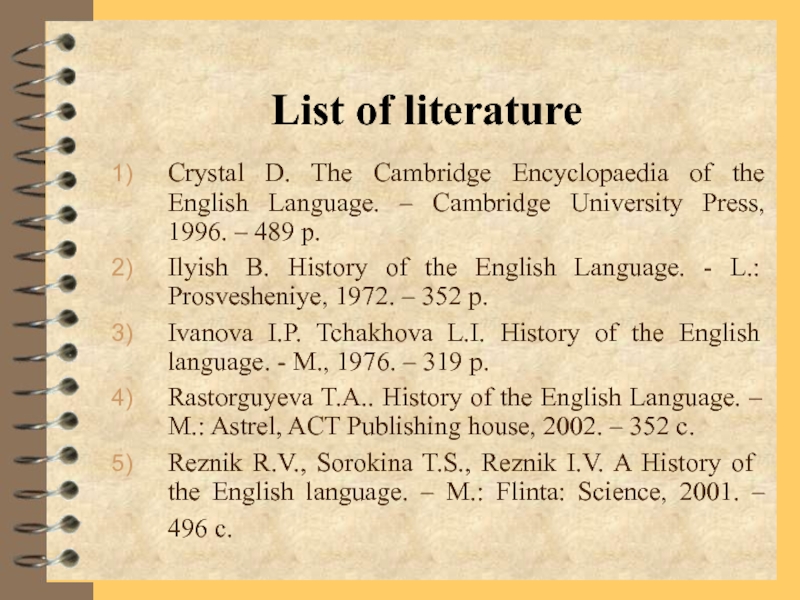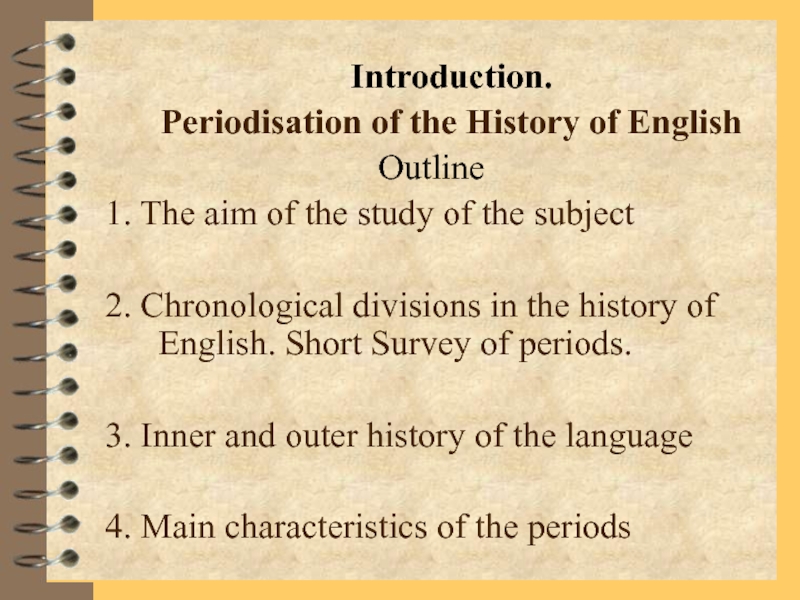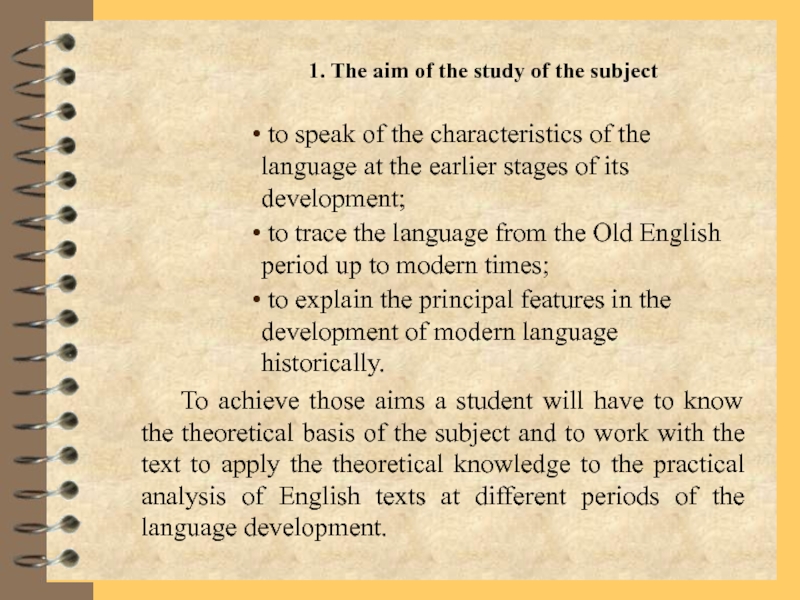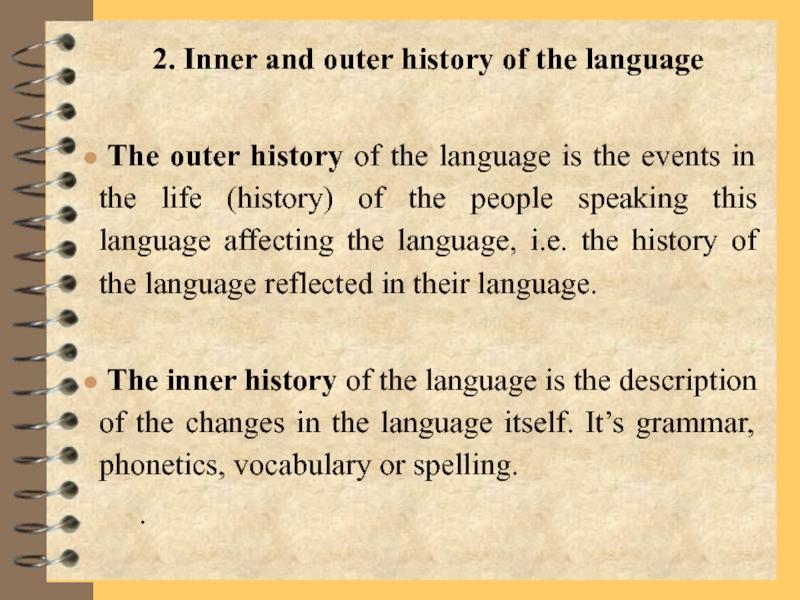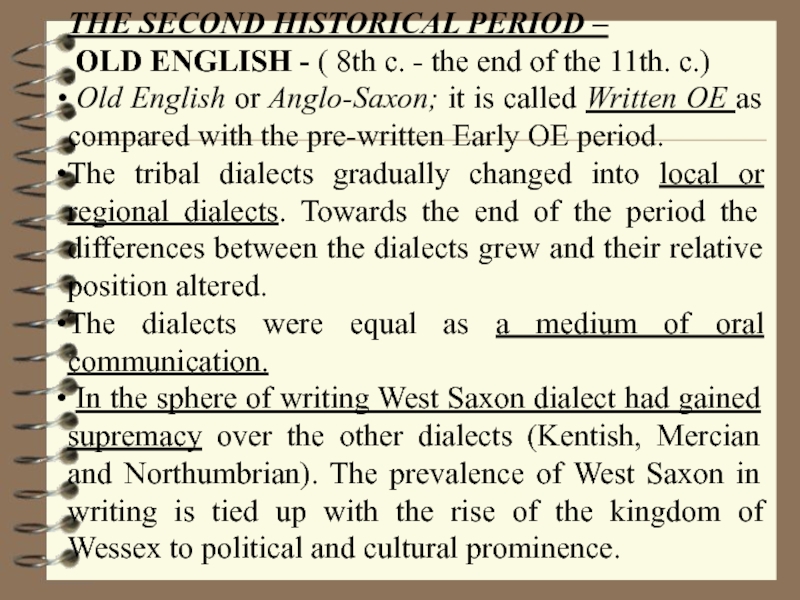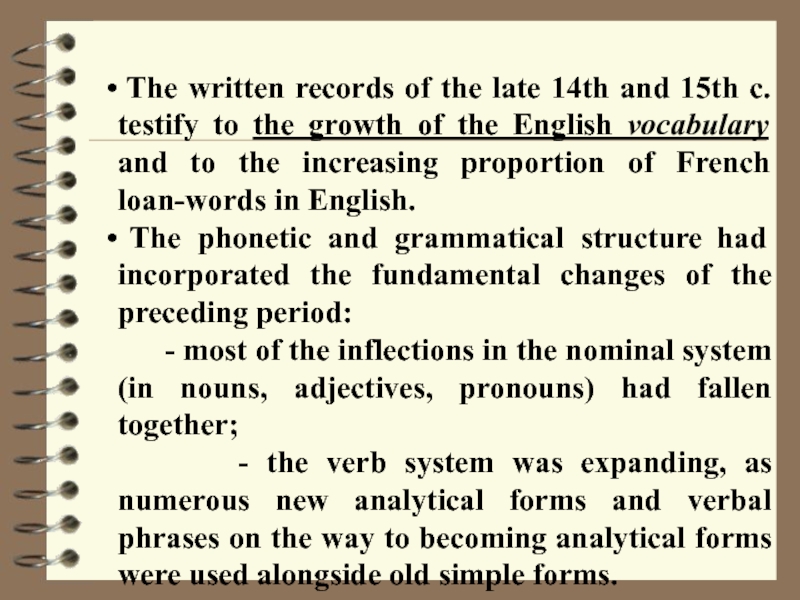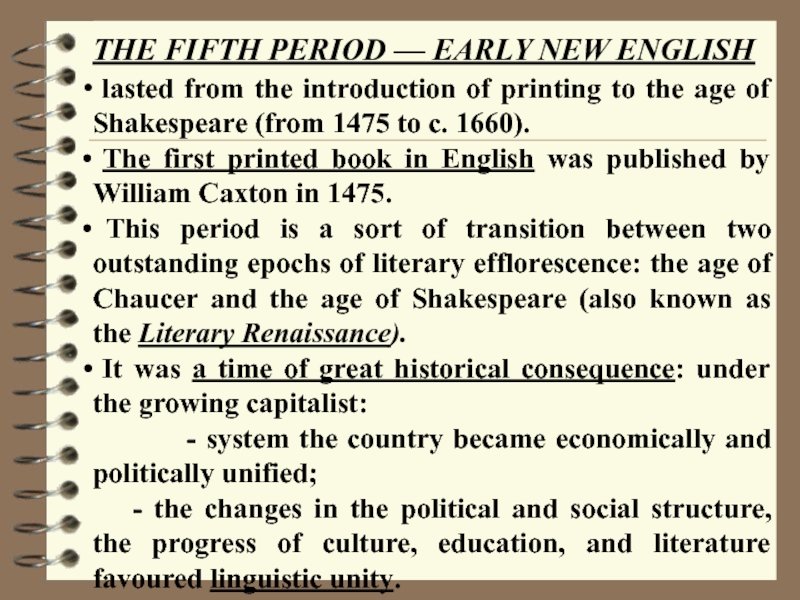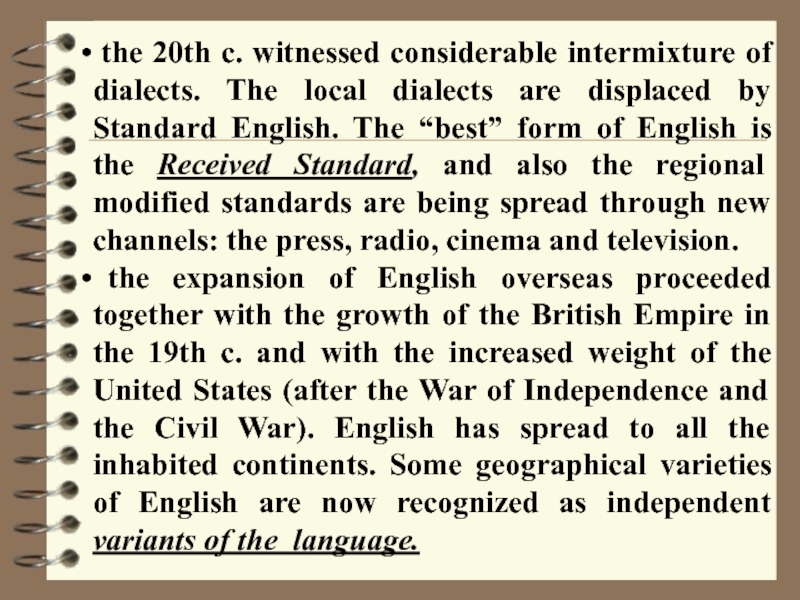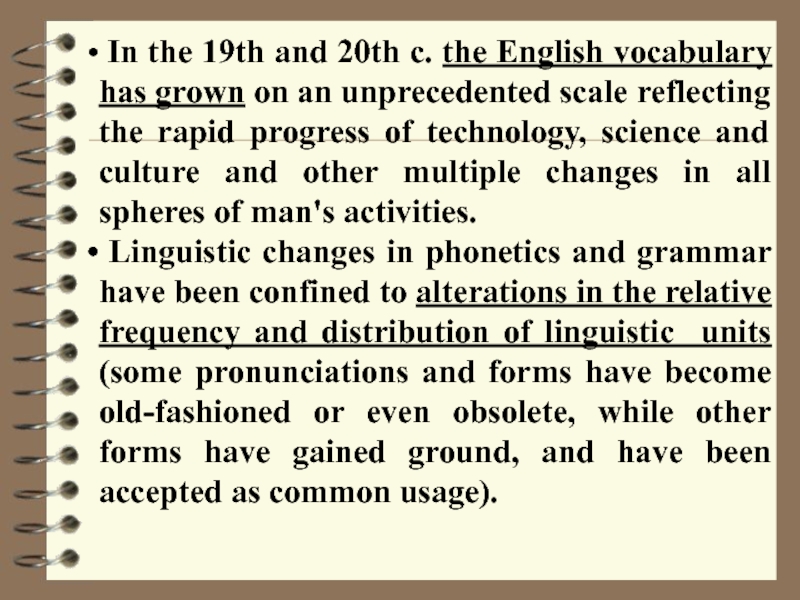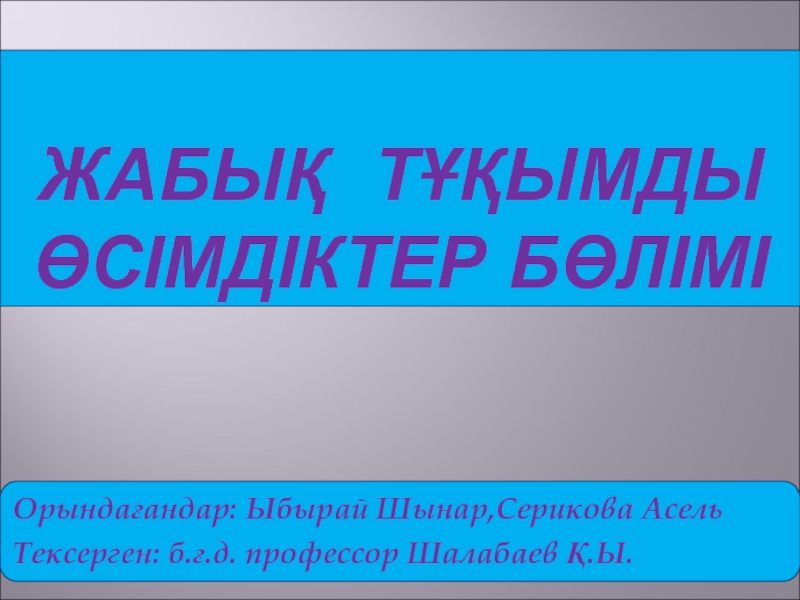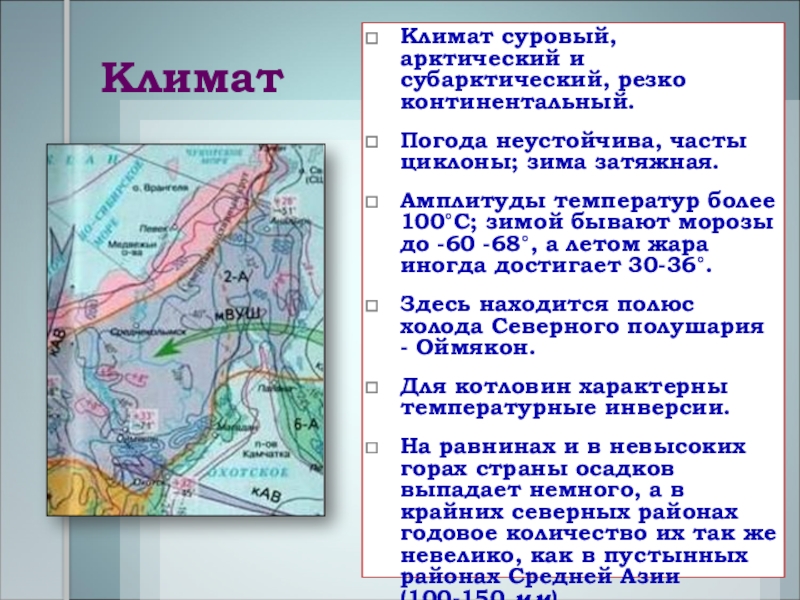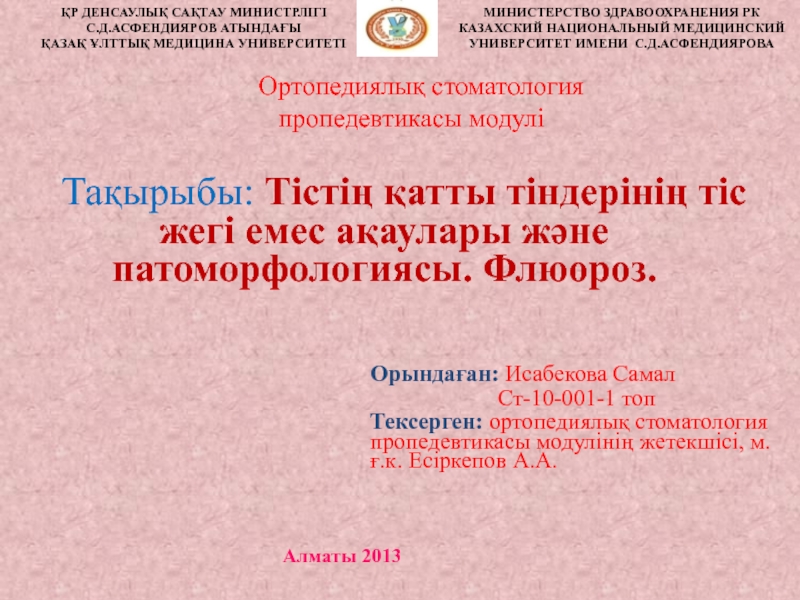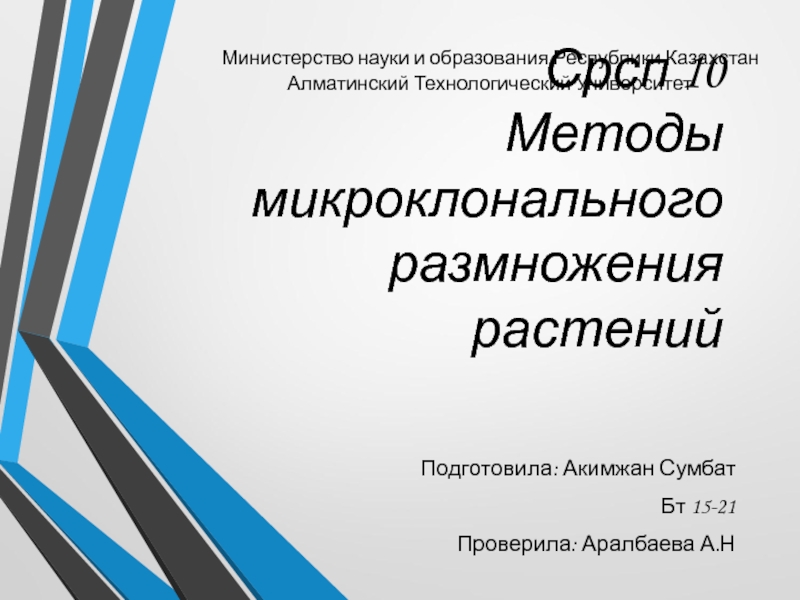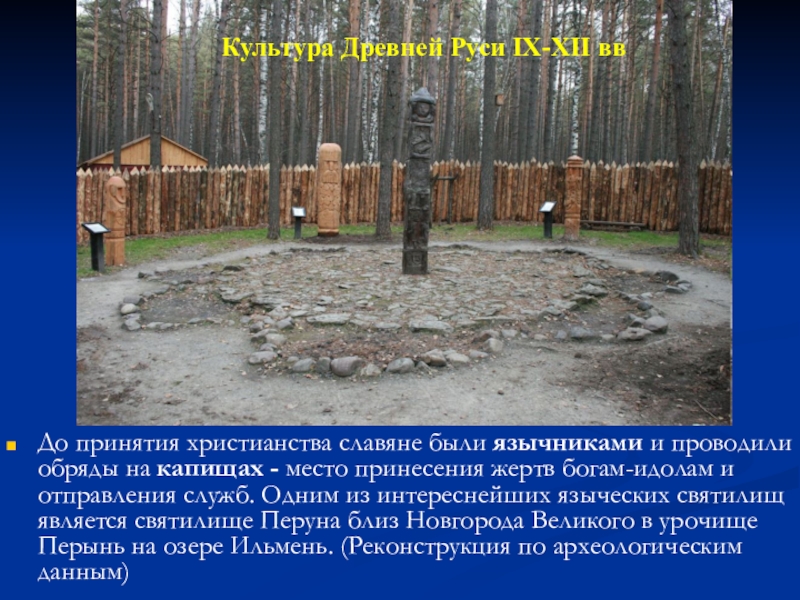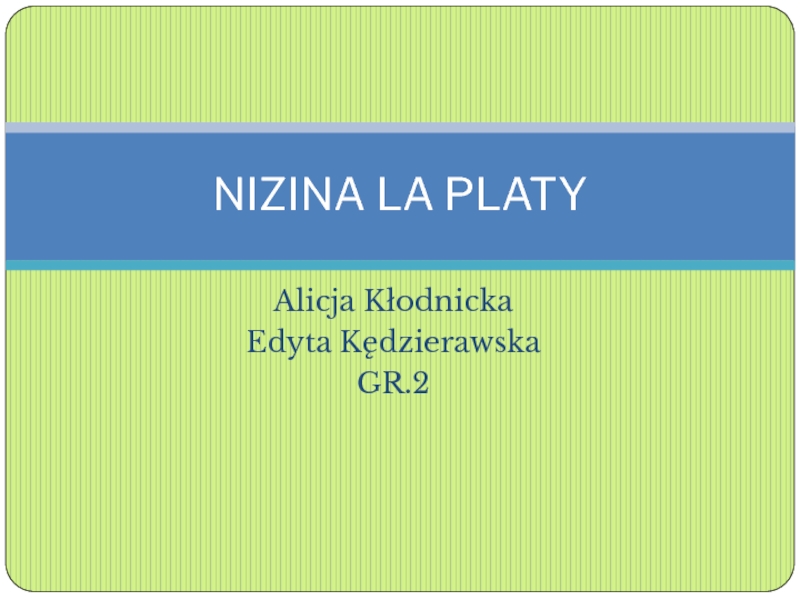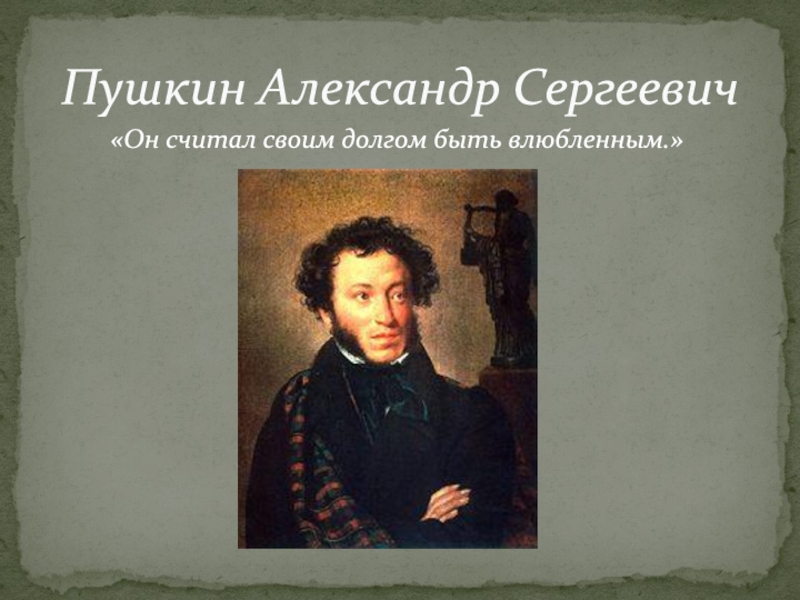Разделы презентаций
- Разное
- Английский язык
- Астрономия
- Алгебра
- Биология
- География
- Геометрия
- Детские презентации
- Информатика
- История
- Литература
- Математика
- Медицина
- Менеджмент
- Музыка
- МХК
- Немецкий язык
- ОБЖ
- Обществознание
- Окружающий мир
- Педагогика
- Русский язык
- Технология
- Физика
- Философия
- Химия
- Шаблоны, картинки для презентаций
- Экология
- Экономика
- Юриспруденция
History of English
Содержание
- 1. History of English
- 2. List of literatureCrystal D. The Cambridge Encyclopaedia
- 3. Introduction. Periodisation of the History of English
- 4. 1. The aim of the study of
- 5. "We cannot know too much about the
- 6. The history of the English language is
- 7. Henry Sweet’s division of the history of
- 8. Periodization of the History of English according
- 9. 2. Inner and outer history of the
- 10. THE FIRST - PRE-WRITTEN OR PRE-HISTORICAL —
- 11. THE SECOND HISTORICAL PERIOD – OLD ENGLISH
- 12. OE WAS A TYPICAL OLD GERMANIC LANGUAGE:
- 13. THE THIRD PERIOD - EARLY MIDDLE ENGLISH
- 14. Early ME was a time of great
- 15. THE FOURTH PERIOD - LATE OR CLASSICAL
- 16. The written records of the late
- 17. THE FIFTH PERIOD — EARLY NEW ENGLISH
- 18. The growth of the English nation was
- 19. THE SIXTH PERIOD - "THE AGE OF
- 20. Unlike the age of Shakespeare, the neo-classical
- 21. THE SEVENTH PERIOD — LATE NEW ENGLISH
- 22. the 20th c. witnessed considerable intermixture
- 23. In the 19th and 20th c.
- 24. Though most of these
- 25. Скачать презентанцию
List of literatureCrystal D. The Cambridge Encyclopaedia of the English Language. – Cambridge University Press, 1996. – 489 p.Ilyish B. History of the English Language. - L.: Prosvesheniye, 1972. – 352
Слайды и текст этой презентации
Слайд 2List of literature
Crystal D. The Cambridge Encyclopaedia of the English
Language. – Cambridge University Press, 1996. – 489 p.
Ilyish B.
History of the English Language. - L.: Prosvesheniye, 1972. – 352 p.Ivanova I.P. Tchakhova L.I. History of the English language. - M., 1976. – 319 p.
Rastorguyeva T.A.. History of the English Language. – M.: Astrel, ACT Publishing house, 2002. – 352 с.
Reznik R.V., Sorokina T.S., Reznik I.V. A History of the English language. – M.: Flinta: Science, 2001. – 496 с.
Слайд 3Introduction.
Periodisation of the History of English
Outline
1. The aim
of the study of the subject
2. Chronological divisions in the
history of English. Short Survey of periods.3. Inner and outer history of the language
4. Main characteristics of the periods
Слайд 41. The aim of the study of the subject
to
speak of the characteristics of the language at the earlier
stages of its development;to trace the language from the Old English period up to modern times;
to explain the principal features in the development of modern language historically.
To achieve those aims a student will have to know the theoretical basis of the subject and to work with the text to apply the theoretical knowledge to the practical analysis of English texts at different periods of the language development.
Слайд 5
"We cannot know too much about the language we speak
every day of our lives... knowledge is power. The power
of rightly chosen words is very great, whether these words are intended to inform, to entertain or to move."Simeon Potter, Our language
Thus the main purpose of studying the history of the English language is to account for the present-day stage of the language to enable a student of English to read books and speak the language with understanding and due knowledge of the intricate and complicated “mechanism” they use.
Слайд 6
The history of the English language is generally subdivided conventionally
into:
Old English (5th – 11th century)
Middle English (11th
– 15th century)New English (15th century – till now).
PERIODIZATION
Слайд 7Henry Sweet’s division of the history of English according to
the state of unstressed endings (1845-1912)
1st period, Old
English — the period of full endings. (any vowel may be found in an unstressed ending).
e.g. the word sinan ‘sing’ has the vowel a in its unstressed ending, while the word sunu ‘son’ has the vowel u in a similar position.
2nd period, Middle English — the period of levelled endings. (vowels of unstressed endings have been levelled under a neutral vowel, represented by the letter e).
e.g. OE sinan > ME singen, OE sunu > E sune (also spelt sone).
3d period, New English — the period of lost endings.
( the ending is lost altogether).
e.g. ME singeng > NE 'sing'. ME sone > NE 'son'.
This division is based on both phonetic (weakening and loss of unstressed vowel sounds) and morphological (weakening and loss of grammatical morphemes) features.
Слайд 8Periodization of the History of English according to T.A. Rastorguyeva
Early
OE (also: Pre-written OE) c. 450 —c. 700
OE (also: Written
OE) c. 700—1066 OEEarly ME 1066— c. 1350
ME (also: Classical ME) c. 1350—1475 ME
Early NE1476 — c. 1660
Normalisation Period (also: Age of Correctness, Neo-Classical period) c.1660—c. 1800
Late NE, or Mod E (including Present-day English)
c. 1800 . . . . .since 1945 ... NE
Слайд 92. Inner and outer history of the language
The outer
history of the language is the events in the life
(history) of the people speaking this language affecting the language, i.e. the history of the language reflected in their language.The inner history of the language is the description of the changes in the language itself. It’s grammar, phonetics, vocabulary or spelling.
.
Слайд 10THE FIRST - PRE-WRITTEN OR PRE-HISTORICAL — PERIOD is
termed EARLY OLD ENGLISH.
It lasts from the West Germanic
invasion of Britain till the beginning of writing (from the 5th to the close of the 7th c.). It is the stage of tribal dialects of the West Germanic invaders (Angles, Saxons, Jutes, and Frisians), which were gradually losing contacts with the related continental tongues. The tribal dialects were used for oral communication, there was no written form of English.
The evolution of the language in this period is hypothetical. It has been reconstructed from the written evidence of other Old Germanic languages (esp. Gothic) and from later OE written records.
It was the period of transition from PG to Written OE.
Early OE linguistic changes, particularly numerous sound changes, marked OE off from PG and from other OG languages.
Слайд 11THE SECOND HISTORICAL PERIOD –
OLD ENGLISH - ( 8th
c. - the end of the 11th. c.)
Old English
or Anglo-Saxon; it is called Written OE as compared with the pre-written Early OE period. The tribal dialects gradually changed into local or regional dialects. Towards the end of the period the differences between the dialects grew and their relative position altered.
The dialects were equal as a medium of oral communication.
In the sphere of writing West Saxon dialect had gained supremacy over the other dialects (Kentish, Mercian and Northumbrian). The prevalence of West Saxon in writing is tied up with the rise of the kingdom of Wessex to political and cultural prominence.
Слайд 12 OE WAS A TYPICAL OLD GERMANIC LANGUAGE:
with a purely
Germanic vocabulary, and few foreign borrowings;
it displayed specific phonetic
peculiarities, owing to intensive changes which took place in Early OE;grammatically OE was an inflected or “synthetic” language with a well-developed system of morphological categories, especially in the noun and adjective, and with an elaborate grouping of all inflected parts of speech into morphological classes.
The decline of the morphological system began in the Northern dialects in the 10th and 11th c.
Слайд 13THE THIRD PERIOD - EARLY MIDDLE ENGLISH
starts after
1066 (the Norman Conquest), and covers the 12th, 13th and
half of the 14th c.it was the stage of the greatest dialectal divergence caused by the feudal system and by foreign influences — Scandinavian and French. The dialectal division of present-day English owes its origin to this period of history.
Under Norman rule the official language in England was French, or rather its variety called Anglo-French or Anglo-Norman; it was also the dominant language of literature.
There is an obvious gap in the English literary tradition in the 12th c. The local dialects were mainly used for oral communication and were but little employed in writing. Towards the end of the period their literary prestige grew, as English began to displace French in the sphere of writing, as well as in many other spheres.
Dialectal divergence and lack of official English made a favourable environment for intensive linguistic change.
Слайд 14Early ME was a time of great changes at all
the levels of the language, especially in lexis and grammar.
English absorbed two layers of lexical borrowings; the Scandinavian element in the North-Eastern area (due to the Scandinavian invasions since the 8th c.) and the French element in the speech of townspeople in the South-East, especially in the higher social strata (due to the Norman Conquest).
Phonetic and grammatical changes proceeded at a high rate, unrestricted by written tradition. Grammatical alterations were so drastic that by the end of the period they had transformed English from a highly inflected language into a mainly analytical one (for the most part, they affected the nominal system). Accordingly, the role of syntactical means of word connection grew.
Слайд 15THE FOURTH PERIOD - LATE OR CLASSICAL MIDDLE ENGLISH
from the later 14th c. till the end of the
I5ththe age of Chaucer, the greatest English medieval writer and forerunner of the English Renaissance.
It was the time of the restoration of English to the position of the state and literary language and the time of literary flourishing.
The main dialect used in writing and literature was the mixed dialect of London. Chaucer's language was a recognised literary form.
Literary flourishing had a stabilising effect on language, so that the rate of linguistic changes was slowed down.
At the same time the written forms of the language developed and improved.
Слайд 16
The written records of the late 14th and 15th
c. testify to the growth of the English vocabulary and
to the increasing proportion of French loan-words in English.The phonetic and grammatical structure had incorporated the fundamental changes of the preceding period:
- most of the inflections in the nominal system (in nouns, adjectives, pronouns) had fallen together;
- the verb system was expanding, as numerous new analytical forms and verbal phrases on the way to becoming analytical forms were used alongside old simple forms.
Слайд 17THE FIFTH PERIOD — EARLY NEW ENGLISH
lasted from the
introduction of printing to the age of Shakespeare (from 1475
to c. 1660).The first printed book in English was published by William Caxton in 1475.
This period is a sort of transition between two outstanding epochs of literary efflorescence: the age of Chaucer and the age of Shakespeare (also known as the Literary Renaissance).
It was a time of great historical consequence: under the growing capitalist:
- system the country became economically and politically unified;
- the changes in the political and social structure, the progress of culture, education, and literature favoured linguistic unity.
Слайд 18 The growth of the English nation was accompanied by the
formation of the NATIONAL ENGLISH LANGUAGE.
The Early NE period was
a time of changes at all
levels, in the first place lexical and phonetic:the growth of the vocabulary (new words from internal and external sources enriched the vocabulary);
extensive phonetic changes were transforming the vowel system, which resulted in the growing gap between the written and the spoken forms of the word (that is, between pronunciation and spelling);
the loss of most inflectional endings;
the inventory of grammatical forms and syntactical constructions was almost the same as in NE, but their use was different.
The abundance of grammatical units occurring without restrictions or regularities produces an impression of great “freedom of grammatical construction”.
Слайд 19THE SIXTH PERIOD - "THE AGE OF NORMALIZATION AND CORRECTNESS“
(in the history of literature — the “neo-classical” age)
from
the mid-17th c. to the close of the 18th c.This age witnessed the establishment of "norms", which can be defined as received standards recognized as correct at the given period.
The norms were fixed as rules and prescriptions of correct usage in the numerous dictionaries and grammar-books published at the time and were spread through education and writing.
Слайд 20Unlike the age of Shakespeare, the neo-classical period discouraged variety
and free choice in pronunciation, vocabulary and grammar.
the
18th c. has been called the period of “fixing the pronunciation”. The great sound shifts were over and pronunciation was being stabilized.word usage and grammatical construction were subjected to restriction and normalization.
the morphological system, particularly the verb system, acquired a more strict symmetrical pattern.
the formation of new verbal grammatical categories was completed.
syntactical structures were perfected and standardized.
Слайд 21THE SEVENTH PERIOD —
LATE NEW ENGLISH OR MODERN ENGLISH
the 19th and 20th c.
by the 19th c.
English had achieved the relative stability typical of an age of literary florescence and had acquired all the properties of a national language, with its functional stratification and recognized standards.the classical language of literature was strictly distinguished from the local dialects and the dialects of lower social ranks. The dialects were used in oral communication and had no literary tradition.
Слайд 22 the 20th c. witnessed considerable intermixture of dialects. The
local dialects are displaced by Standard English. The “best” form
of English is the Received Standard, and also the regional modified standards are being spread through new channels: the press, radio, cinema and television.the expansion of English overseas proceeded together with the growth of the British Empire in the 19th c. and with the increased weight of the United States (after the War of Independence and the Civil War). English has spread to all the inhabited continents. Some geographical varieties of English are now recognized as independent variants of the language.
Слайд 23 In the 19th and 20th c. the English vocabulary
has grown on an unprecedented scale reflecting the rapid progress
of technology, science and culture and other multiple changes in all spheres of man's activities.Linguistic changes in phonetics and grammar have been confined to alterations in the relative frequency and distribution of linguistic units (some pronunciations and forms have become old-fashioned or even obsolete, while other forms have gained ground, and have been accepted as common usage).
Слайд 24
Though most of these changes are
difficult to notice and to define, it is apparent that
an English speaker of the 1950s or 1980s uses a form of language different from that used by the characters of Dickens or Thackeray one hundred and fifty years ago.Therefore we may be fully justified in treating the 19th and 20th c. as one historical period in a general survey of the history of English.
But in order to describe the kind of English used today and to determine the tendencies at work now, the span of the last thirty or forty years can be singled out as the final stage of development, or as a cross-section representing Present-day English.

